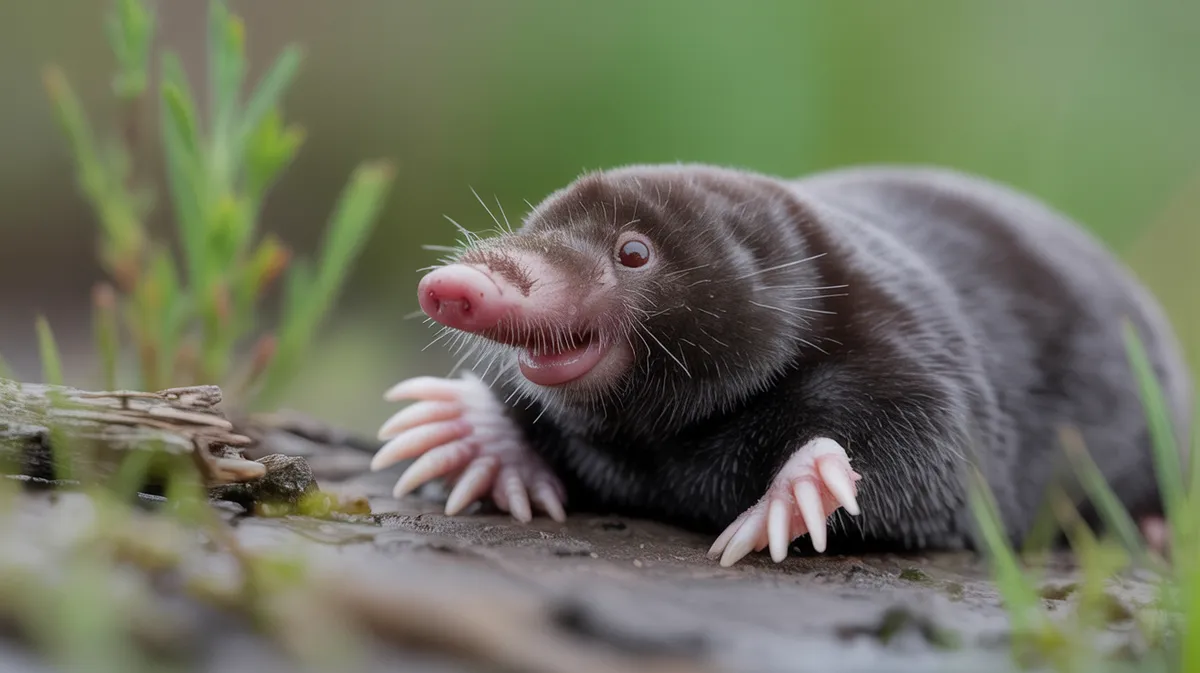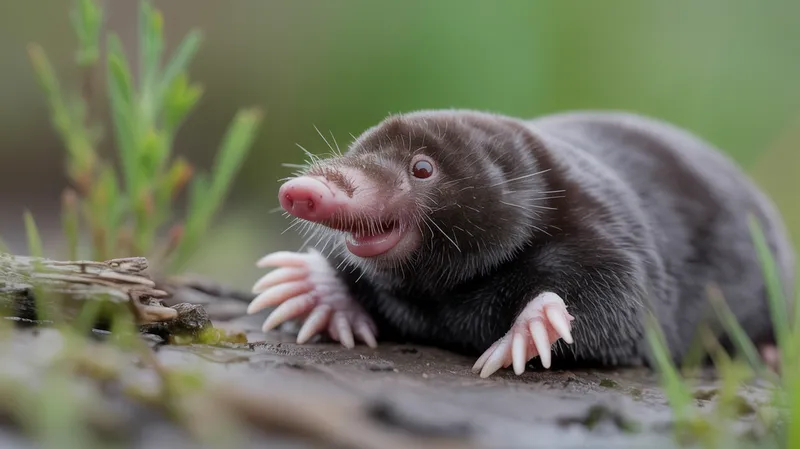
Star-nosed Mole
Condylura cristata

Meet the Star-nosed Mole
The star-nosed mole is a small, semi-aquatic mammal renowned for its unique star-shaped nose, which is ringed with 22 fleshy appendages. These appendages are covered in thousands of highly sensitive receptors, enabling the mole to detect prey with remarkable speed and precision, even in complete darkness. Star-nosed moles are excellent diggers and swimmers, inhabiting wetlands and moist soils throughout northeastern North America. Their specialized nose makes them the fastest foraging mammal, able to identify and consume prey in a fraction of a second. Despite their strange appearance, they play a crucial role in wetland ecosystems.
Classification
Mammal
Habitat
Wetlands, marshes, and moist lowland forests
Diet
Carnivore
Lifespan
2-4 years
Conservation
Least Concern
Weight
35-75 grams
📖Fascinating Facts
Unique Nose
The star-nosed mole’s nose is tipped with 22 pink, fleshy tentacles that are highly sensitive and help it detect prey in complete darkness.
Fastest Eater
It holds the record for the fastest foraging time among mammals, sometimes locating and consuming prey in just 120 milliseconds.
Aquatic Abilities
Unlike most moles, the star-nosed mole is an excellent swimmer and forages for insects, worms, and small aquatic animals underwater.
📋Detailed Description
The star-nosed mole (Condylura cristata) is a small, semi-aquatic mammal measuring 15–20 cm (6–8 in) in total length, including a 2.5–4 cm (1–1.6 in) tail, and weighing between 35–75 grams (1.2–2.6 oz). Its most distinctive feature is the star-shaped structure at the tip of its snout, composed of 22 pink, fleshy appendages called rays, each densely packed with mechanosensory Eimer’s organs—over 25,000 in total. The fur is dense, velvety, and water-repellent, typically dark brown to black, aiding in both insulation and movement through water and soil. The forelimbs are broad and paddle-like, highly adapted for digging, while the hind feet are larger and fringed, enhancing swimming ability. The eyes are tiny and functionally blind, reflecting the mole’s reliance on tactile and olfactory senses. The tail is thick and cylindrical, serving as a fat storage organ, especially enlarged in winter. Internally, the star-nosed mole has a high metabolic rate and a unique hemoglobin structure that allows efficient oxygen uptake in low-oxygen environments. Its brain is specialized for rapid sensory processing, particularly in the somatosensory cortex, which is disproportionately large compared to other moles. The species is active year-round, both above and below ground, and is capable of foraging underwater, making it one of the few truly semi-aquatic moles.
💡 Did you know?
The star-nosed mole is the only mole known to smell underwater by exhaling and re-inhaling air bubbles.
🔬Research & Sources
Wikipedia Summary
The star-nosed mole is a small semiaquatic mole found in moist, low elevation areas in the northeastern parts of North America. It is the only extant member of the tribe Condylurini and genus Condylura. It has more than 25,000 minute sensory receptors in touch organs, known as Eimer's organs, with which this hamster-sized mole feels its way around. With the help of its Eimer's organs, it may be perfectly poised to detect seismic wave vibrations.
Last Modified: 4/20/2025
🎭Behavior & Social Structure
Star-nosed moles are solitary and territorial, with overlapping home ranges only during the breeding season. They construct extensive tunnel systems in moist soils, often with underwater entrances and foraging galleries. Their daily activity is polyphasic, consisting of alternating bouts of foraging and rest throughout the 24-hour cycle. Foraging behavior is characterized by rapid, repetitive probing of the substrate with the star appendages; prey is detected and consumed in as little as 120 milliseconds, making them the fastest known mammalian foragers. Diet consists primarily of aquatic invertebrates (worms, insect larvae, mollusks, crustaceans), but also includes small fish and amphibians. The mole can swim and dive efficiently, using its sensitive star to locate prey underwater by touch and possibly by detecting weak electrical signals. Social interactions are rare outside of mating, and individuals communicate primarily through scent marking and occasional vocalizations.
👶Reproduction & Life Cycle
Breeding occurs once annually, typically from March to April, depending on latitude and local climate. Males and females come together briefly for mating, after which males leave and provide no parental care. Gestation lasts approximately 45 days. Females give birth to a single litter per year, usually containing 4–5 pups (range 2–7). The young are born blind and hairless in an underground nest lined with vegetation. Eyes open at about 14 days, and the star appendages become functional within the first week. Weaning occurs at 3–4 weeks, after which juveniles disperse to establish their own territories. Sexual maturity is reached at 10–11 months, allowing for reproduction in the following breeding season.
🛡️Adaptations & Survival
The star-nosed mole exhibits several remarkable adaptations: its star-shaped nose is the most sensitive touch organ in the animal kingdom, enabling the detection of minute prey items in complete darkness or murky water. The Eimer’s organs on the star can detect vibrations and possibly weak electrical fields, aiding in prey localization. The mole’s fur is hydrophobic, reducing drag and maintaining body temperature during aquatic foraging. Its lungs and blood are adapted for brief dives, and the tail stores fat for energy during winter. The mole’s nervous system is highly specialized, with rapid signal transmission from the star to the brain, supporting its extraordinary foraging speed. Behavioral adaptations include constructing both terrestrial and aquatic tunnels, and the ability to forage under ice in winter.
🎨Cultural Significance
The star-nosed mole is not a significant figure in folklore or traditional medicine, likely due to its secretive, subterranean lifestyle and limited direct contact with humans. However, its bizarre appearance and extraordinary sensory adaptations have made it a subject of fascination in popular science, nature documentaries, and educational materials. It is often cited as an example of extreme evolutionary specialization and is used in neuroscience research to study tactile processing.
🔬Recent Research & Discoveries
Recent studies have focused on the neurobiology of the star-nosed mole, particularly the organization of its somatosensory cortex and the function of Eimer’s organs. Research published in the last decade has revealed that the star’s central pair of rays acts as a tactile fovea, analogous to the visual fovea in primates, providing the highest resolution touch. Ongoing research investigates the mole’s ability to detect weak electrical fields underwater, a rare trait among mammals. Conservation studies monitor the impact of wetland loss and climate change on distribution. The star-nosed mole is also a model organism for understanding rapid sensory decision-making and adaptation to hypoxic environments.
🎥Wildlife Videos

The Weird and Wonderful Star-Nosed Mole | 4K UHD | Mammals | BBC Earth
Taken from Mammals (2024). On every continent, in every ocean, conquering frozen landscapes and searing deserts – mammals ...
BBC Earth

The bizarre star-nosed mole: The world’s fastest eater
An unusual nose turns this tiny critter's underground habitat into a field-of-plenty. #TheNatureOfThings #TheWildCanadianYear ...
The Nature of Things

The Star Nosed Mole - part two
This is a video of the star nosed mole taken from the BBC's new "Life" documentary series.
globalzoo

Spectacular Insights into the Underground
Many animals feel at home in our gardens. Some are very popular with garden owners, others should disappear as fast as ...
Free High-Quality Documentaries

The Fascinating Life of the Star-Nosed Mole
Dive into the intriguing world of the star-nosed mole in this captivating nature and wildlife video! Discover the unique adaptations ...
US Nature and Wildlife

Is This the World's Weirdest-Looking Killer? | World's Deadliest
#NatGeoWILD #WorldsDeadliest #StarNosedMole About World's Deadliest: World's Deadliest Predators is a new series that looks ...
Nat Geo Animals
🌍Habitat Information
The Star-nosed Mole typically inhabits Wetlands, marshes, and moist lowland forests environments. Star-nosed Moles have adapted to their environments with specialized features and behaviors.
Primary Habitat:
Wetlands, marshes, and moist lowland forests
More detailed habitat information will be available soon.
🛡️Conservation Status
The Star-nosed Mole is currently classified as Least Concern. Conservation efforts are crucial for preserving this species for future generations.
Common Threats:
- 🏠Habitat loss and fragmentation
- 🌡️Climate change impacts
- 🎯Hunting and poaching
- 🏭Human-wildlife conflict
⚠️Threats & Conservation Challenges
Currently classified as Least Concern by the IUCN, the star-nosed mole faces few widespread threats due to its broad range and adaptability. However, localized populations may be affected by wetland drainage, habitat fragmentation, pollution, and climate change, which can alter water tables and reduce suitable habitat. Road mortality and predation by domestic animals are minor threats. The species is not targeted by hunting or trade, but ongoing wetland loss poses a long-term risk. Population trends are considered stable, but continued monitoring is recommended, especially in areas undergoing rapid land-use change.
🔬Scientific Classification
Scientific Name
Condylura cristata
Classification Hierarchy
🔍 About Taxonomic Classification
Taxonomic classification is a hierarchical system used by scientists to classify and organize living organisms based on shared characteristics and evolutionary relationships.
The system moves from broad categories (Kingdom) to increasingly specific ones, with each animal's scientific name typically consisting of its Genus and species.
📝Community Notes
Share your observations and insights about the Star-nosed Mole with our community of wildlife enthusiasts.
Join Our Community
Sign in to share your observations and connect with fellow wildlife enthusiasts.
Sign In to ContributeNo community notes yet
Be the first to share your observations about the Star-nosed Mole!
Explore Star-nosed Mole
Select a tab above to learn more about this amazing animal.
📸Photo Gallery
No photos available for this animal yet.
🌟Discover More Wildlife
Continue your journey of discovery with more fascinating animals from our database
